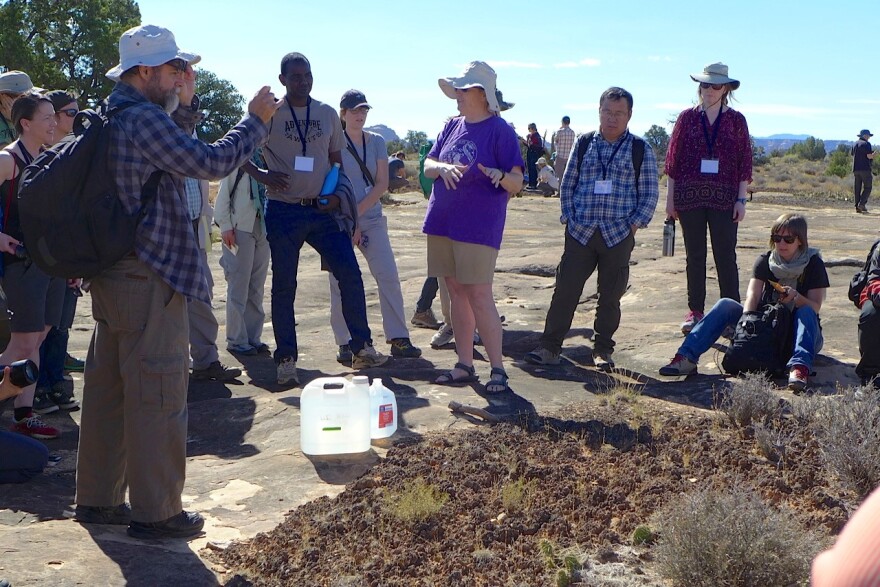It’s been called “cryptogamic” or “microbiotic” or cryptobiotic.” It’s that thin crust of lichens, fungus and moss that grows where nothing else will grow. In the last decade, a growing group of scientists have concluded that this crust is a critical element in the survival of the planet.
If you hear some highway noise, it’ll be worth it, because we get to travel in a van with some of the leading scientists, including Sasha Reed, who is based at the US Geological Survey station in Moab.
“And the first one was in Germany, and the second was in Madrid Spain," Reed said. "And then this is the third event, the largest yet in a growing community of biocrust scientists, and it’s here in little Moab, Utah.”
Reed is co-chair of the conference, along with Matthew Bowker, from Northern Arizona University, who is driving our van. We’re in a fleet of scientists headed for a remote experimental station in the Canyonlands. Bowker lists some of the countries the passengers are from.
“We have the United States, Canada, Mexico, Peru, Brazil, Spain, Germany, France, Niger, Algeria, Israel, China, now I’m slowing down, Australia, Iceland ... I think people should start thinking of crust as the living skin of the earth, and what we want to do is learn how to re-grow the living skin once it has been damaged or lost.”
Riding shotgun is Dr. Jayne Belnap, who heads the Moab USGS station, and who has just received a lifetime achievement award for her role in pioneering this new field.
“Jayne is just epic in the biocrust world," said Reed. "She has been an incredible force of nature in increasing our understanding of biological soil crust, and bringing that community of biocrust scientists together.”
Belnap has published massively on the subject, and was editor of a 2001 book that ultimately made her the pied piper of the biocrust world:

“We have nuked crusts over such a massive landscape in the Western U.S, now we have to start to figure out how to fix it. Utahns really should care about biocrust, and keeping them healthy here. One of the biggest reasons for people on the Wasatch front could relate to them is dust. So we get massive dust storms moving in to the Salt Lake area and Provo and Ogden, coming from the deserts. And mostly that’s the result of soil surface disturbance or fire, both of which will smash the crust and keep them from stabilizing the soil.”
Belnap and her colleagues were the first to observe and study the “pink snow” phenomenon, where desert dust gets blown into the mountains and causes earlier snowmelt. And fugitive dust happens when the crust is suffering.
“Recreation is a huge impact to soil crust in Utah," said Belnap. "But we have really a large amount of work to do to get people to stay on the trails, to stay on the roads, the designated corridors of travel, whether you’re on foot, or on a bike or in a car. Plus, it just looks nicer for everybody visiting. I mean it’s not fun to go somewhere, you’ve put a lot of effort and money in getting there, and what you see is a bunch of tire tracks.”
This isn’t just a Utah thing - modern biocrust science began as a German/American collaboration – when you add up deserts and drylands, we’re talking 40 percent of the planet. Thomas Fisher, from Germany’s University of Technology, was among those examining the robust cryptos in Canyonlands.
“We also have mainly dry regions, but the key is the appearance of these lichens, of algo-crusts, cyanic bacteria, and they are worldwide, even in the Arctic, or Africa, Australia and America, everywhere on every continent.”
That means pink snow in the Himalayas as well as Colorado. But NAU’s Matthew Bawker, after studying crusts in numerous Western states, has become optimistic.
“We’re going to see major breakthroughs in the next ten years. We’ve found that we can grow quite a lot of the crust organisms. Sometimes we can get the ones that we grew to live in the field. So we need to get better at both of those things. And then we need to figure out how to do it big. How do we go big scale? And there’s been some impressive achievements in China that are large, that we should look to and we should perhaps emulate.”




